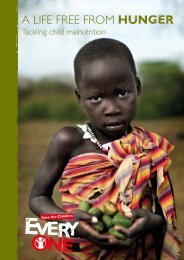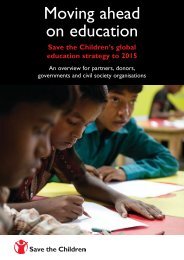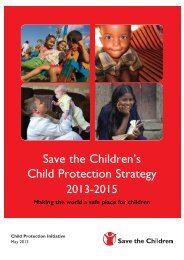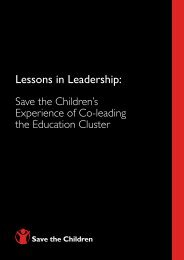NGER A LIFE FREE FROM HUNGER - Save the Children
NGER A LIFE FREE FROM HUNGER - Save the Children
NGER A LIFE FREE FROM HUNGER - Save the Children
Create successful ePaper yourself
Turn your PDF publications into a flip-book with our unique Google optimized e-Paper software.
a life free from hunger<br />
MASS FORTIFICATION<br />
Mass fortification is a cost-effective intervention that uses <strong>the</strong> country’s existing food<br />
delivery system. As production is generally large scale, <strong>the</strong> price increase for <strong>the</strong><br />
consumer is small. In fact, analysis from <strong>the</strong> World Food Programme, using <strong>Save</strong> <strong>the</strong><br />
<strong>Children</strong>’s Cost of Diet tool, shows that, in Mozambique, flour fortification lowers <strong>the</strong><br />
price of <strong>the</strong> minimum cost nutritious diet by 12%, and fortified maize flour lowers family<br />
food expenses by up to 18%. 31 The fortification of staple foods that are widely consumed<br />
by <strong>the</strong> general population means that poorer and more remote communities are likely<br />
to benefit. It does not require families to change what <strong>the</strong>y eat or how <strong>the</strong>y prepare it.<br />
Mass fortification programmes are increasingly common, especially when it comes to<br />
fortified flour and iodised salt. Between 1990 and 2009, for example, <strong>the</strong> number of<br />
households in developing countries consuming iodised salt rose from 20% to 70%. This<br />
coincided with a 43% (110 to 47) reduction between 1993 and 2007 in <strong>the</strong> number of<br />
countries in which iodine-deficiency disorders were a public health concern. 32 O<strong>the</strong>r<br />
programmes have also been successfully undertaken through a range of foods (including<br />
rice, cooking staples, such as sugar and oil, and condiments, such as soy and fish sauces),<br />
with demonstrated impact. 33<br />
The downside of mass fortification is that infants and young children, who have high<br />
micronutrient needs but consume relatively small amounts of staple food, are less<br />
likely to obtain <strong>the</strong> recommended intake this way. However, it can contribute to better<br />
FLOUR POWER IN SOUTH AFRICA<br />
The most effective mass fortification programmes are usually those initiated and<br />
regulated by national government. 34 In 2003, for example, South Africa launched<br />
its National Food Fortification Programme, mandating manufacturers to fortify<br />
bread wheat flour or maize meal with eight micronutrients including vitamin A,<br />
folic acid, iron and zinc.<br />
An impact study found a two-thirds reduction in perinatal (foetal or neonatal)<br />
deaths related to neural tube defects (an opening in <strong>the</strong> spinal cord or brain that<br />
occurs very early in human development), and a 39% reduction in neural tube<br />
defect-related infant mortality. 35<br />
28
















